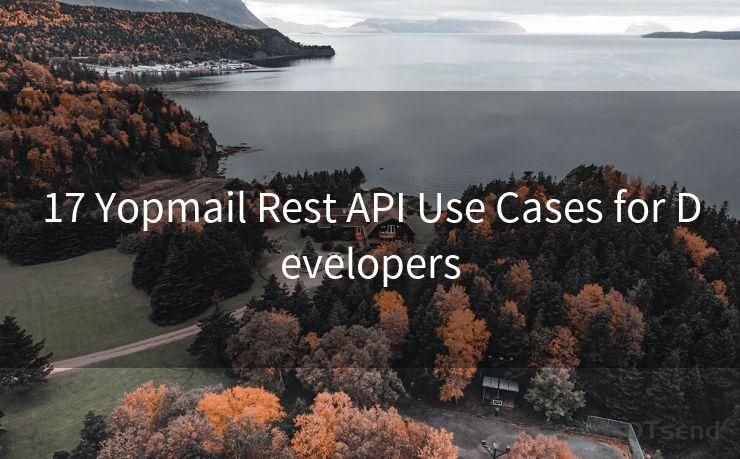Getting a Mailjet API Key—How to Send Email with Mailjet?




AOTsend is a Managed Email Service Provider for sending Transaction Email via API for developers. 99% Delivery, 98% Inbox rate. $0.28 per 1000 emails. Start for free. Pay as you go. Check Top 10 Advantages of Managed Email API
Getting a Mailjet API Key—How to Send Email with Mailjet?
When it comes to sending emails efficiently, the Mailjet API offers a robust solution. In this article, we'll explore how to get a Mailjet API key and leverage it to send emails using Mailjet. Plus, we'll discuss how Aotsend fits into the picture, making your email management even easier.
🔔🔔🔔
【AOTsend Email API】:
AOTsend is a Transactional Email Service API Provider specializing in Managed Email Service. 99% Delivery, 98% Inbox Rate. $0.28 per 1000 Emails.
AOT means Always On Time for email delivery.
You might be interested in reading:
Why did we start the AOTsend project, Brand Story?
What is a Managed Email API, Any Special?
Best 25+ Email Marketing Platforms (Authority,Keywords&Traffic Comparison)
Best 24+ Email Marketing Service (Price, Pros&Cons Comparison)
Email APIs vs SMTP: How they Works, Any Difference?
Understanding the Mailjet API
The Mailjet API is a powerful tool for email marketing and transactional email services. To get started, you need a Mailjet API key, which is essential for authenticating your requests. Once you have this key, you'll be able to access Mailjet’s extensive features for sending and managing emails. The Mailjet API key provides secure and reliable access to Mailjet’s email delivery capabilities.
By using the Mailjet API, you can automate your email campaigns, track delivery rates, and manage email lists with ease. It’s crucial to handle your Mailjet API key securely to prevent unauthorized access to your email services.
How to Obtain Your Mailjet API Key
Getting your Mailjet API key is straightforward. First, sign up for a Mailjet account if you haven’t already. Once logged in, navigate to the API Key Management section in the Mailjet dashboard. Here, you can create a new API key specifically for your application.
When you generate a Mailjet API key, you’ll receive both a public and a private key. These are critical for integrating Mailjet’s services into your application. Store these keys securely and use them according to Mailjet’s best practices to ensure your email operations run smoothly.
Integrating Mailjet API for Sending Emails
With your Mailjet API key in hand, you can now integrate Mailjet into your application to send emails. The Mailjet API provides various endpoints to handle email sending, including both basic and advanced features. To send an email using the Mailjet API, you'll need to make a POST request to the email sending endpoint with your API key and email details.
For example, using Mailjet’s API, you can specify the sender, recipient, subject, and content of your email. The Mailjet API will handle the rest, ensuring your message is delivered efficiently. It’s recommended to refer to Mailjet’s documentation for detailed instructions and examples to make the most of the Mailjet API.
Utilizing Aotsend with Mailjet API
Aotsend is an additional tool that complements the Mailjet API, providing a streamlined interface for managing your email campaigns. By integrating Aotsend with your Mailjet API key, you can enhance your email management capabilities. Aotsend simplifies the process of setting up and sending email campaigns, making it easier to leverage the full potential of the Mailjet API.
When using Aotsend with the Mailjet API, you can benefit from advanced features such as scheduling emails, segmenting your audience, and analyzing campaign performance. This integration allows you to focus on crafting compelling emails while Aotsend and Mailjet handle the technical aspects of email delivery.
Best Practices for Using Mailjet API
To make the most of the Mailjet API, follow these best practices. Always keep your Mailjet API key confidential and rotate it periodically to enhance security. Monitor your email campaigns through Mailjet’s reporting tools to ensure high deliverability and engagement rates.
Additionally, make use of Mailjet’s analytics to track performance metrics and optimize your email strategies. Combining the insights from Mailjet’s analytics with Aotsend’s user-friendly interface can significantly boost your email marketing efforts.
In conclusion, obtaining and using a Mailjet API key is essential for leveraging Mailjet’s email services effectively. Integrating the Mailjet API into your application allows for seamless email delivery and management. When combined with Aotsend, you gain additional tools to enhance your email marketing capabilities. Remember to follow best practices to ensure your email campaigns are successful and secure.
By mastering the Mailjet API and utilizing tools like Aotsend, you’ll be well-equipped to handle all your email communication needs with confidence.





AOTsend adopts the decoupled architecture on email service design. Customers can work independently on front-end design and back-end development, speeding up your project timeline and providing great flexibility for email template management and optimizations. Check Top 10 Advantages of Managed Email API. 99% Delivery, 98% Inbox rate. $0.28 per 1000 emails. Start for free. Pay as you go.
Scan the QR code to access on your mobile device.
Copyright notice: This article is published by AotSend. Reproduction requires attribution.
Article Link:https://www.aotsend.com/blog/p83.html





